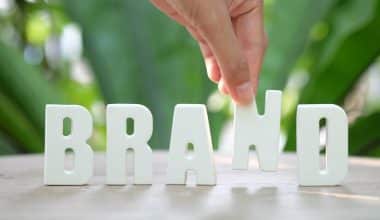Building a brand and making it prominent can be accomplished in several ways. Nonetheless, choosing the best strategies and ideas to raise the company’s brand awareness poses a challenge for marketers. Making the right investment decisions is essential for marketers who want to maximize their profits.
While many old brand awareness strategies and ideas are being scrapped, new ones are becoming more effective. Because of this, marketers must understand these strategies and take swift action with them. If you’re looking for great ideas, check out this guide for quirky ways to increase brand awareness.
Key Points:
- Brand awareness is a marketing term that refers to how familiar your target audience is with your brand and how well they recognize it.
- Brand awareness is measured using a combination of quantitative and qualitative metrics to assess the effectiveness of marketing efforts over time.
- Brand equity describes the value of having a well-known brand name, which arises from good brand awareness.
- Brand awareness is important because it establishes trust with your customers, creates positive associations, and builds invaluable brand equity, allowing your brand to become a household name and consumer staple.
- Top-of-mind awareness (TOMA) is the highest form of brand awareness, and it’s when a brand is the first thing that comes to mind when a consumer thinks of a product or industry.
What Is Brand Awareness?
Brand awareness is a marketing term that refers to how familiar your target audience is with your brand and how well they recognize it. A small business’s brand awareness level may not reach eponym status (e.g., asking for a Kleenex instead of a tissue), but simpler forms are counted as success. This could mean:
- Consumers know what your business is known for.
- A Social media user knows your ad will be funny when they see you in their feed.
- Customers choose your brand specifically over others, even if there are cheaper options.
- Search engine users type your business name or other branded terms into search.
When your consumers have brand awareness, they often learn more about your business because they know it exists and are actively seeking out information rather than discovering it in a Google or Yelp search.
Why Brand Awareness Is Important
As discussed earlier, brand awareness is vital to driving online searches for your brand name. It also plays a significant role in consumers’ purchase decisions in the broader marketplace when confronted with multiple choices.
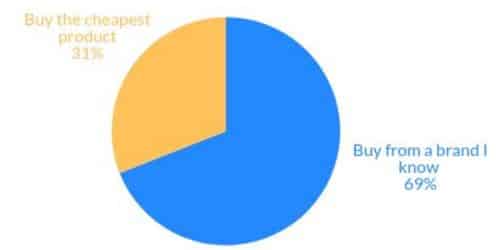
When asked whether they would prefer to buy the cheapest product or one from a brand they know, 69% of consumers would choose the brand they’re familiar with. In the marketing industry, this pulling power is known as ‘brand equity.’
Brand equity describes the value of having a well-known brand name — and it’s what arises from having good brand awareness. The CEOs of household name brands understand how important it is to have brand equity because it directly impacts the bottom line. Ultimately, the ROI of brand awareness includes:
#1. Brand Awareness Fosters Trust
Brand trust is crucial in a world where customers base their purchasing decisions on in-depth research and the views of others. Customers who become emotionally attached to your brand are more inclined to repurchase it with little consideration, which closes the loyalty and trust gap.
Brand trust is established by brand awareness. Customers are more likely to trust a brand with a tangible face. Efforts to raise brand recognition give your company a personality and a platform for sincerity, feedback, and storytelling. These are all methods by which humans establish mutual trust. The link between a person and a brand is the same.
#2. It Creates Association
I bet you’ve put on a Band-Aid when you’ve had a paper cut. When you have a pressing question, I’m sure you’ve Googled it. When you need to make a few copies, I guess you Xeroxed them. And when you’ve packed for a nice picnic, I will bet you grabbed a Coke to drink.
Am I correct? Most likely. But … notice how some of the words above are capitalized. These are brands, not nouns or verbs.
Speaking in brand-less terms, Band-Aid should be referred to as a bandage, Google as a search engine, and Xerox as a copier. But it’s more fun to refer to the brand itself, even if we aren’t using their specific product.
Brand awareness does this. It associates actions and products with particular brands, subconsciously encouraging us to replace common words with branded terms. Before you know it, simple paper cuts or picnics are marketing for us.
#3. Brand Awareness Builds Brand Equity
Brand equity describes a brand’s value, determined by consumer experiences and overall brand perception. Positive experiences and perceptions equal positive brand equity; the same goes for negative notions.
Here are a few valuable things that come from positive brand equity:
- Higher prices due to higher perceived value
- A higher stock price
- The ability to expand business through product or service line extensions
- More significant social impact due to brand name value
How does a brand establish (and increase) brand equity? By building brand awareness and consistently promoting positive experiences with the brand. Brand awareness is the foundation of brand equity.
Once consumers are aware of a brand, they start to recognize it without assistance, seek it out to make a purchase, prefer it over similar brands, and establish a loyalty that spurs other purchases and inspires recommendations to family and friends.
That is why brand awareness is so important. It establishes trust with your customers, creates positive associations, and builds invaluable brand equity, allowing your brand to become a household name and consumer staple.
Brand Recognition vs. Brand Awareness: What’s the Difference?
Brand recognition is how a consumer can correctly identify your brand based on visual indicators such as logos and colors. For example, if you see the Dunkin Donuts pink and orange letters up ahead before even making out the words, you automatically recognize them as Dunkin Donuts.
Brand awareness takes brand recognition a step further. It involves recalling not only the business name (ideas for creative business names here!) but also the general feeling of the business, information about its products and services, and other experiential details. When a company has a level of brand awareness, its marketing and advertising campaigns mean something to its audience. They elicit feelings in the consumer.
Brand Awareness Examples
Are you unsure of what a brand awareness campaign can look like? Let’s examine some top examples.
#1. Apple Events
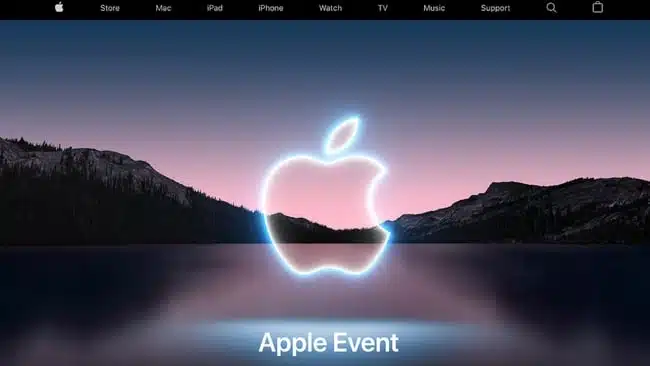
We all know companies that release new gadgets and features to keep their product lines current. However, none of these have reached Apple’s level of fame, and that’s because Apple hosts an entire event dedicated to announcing its new releases.
Even though the updates to the products are minimal, Apple has “hyped up” the event to such a degree that you know automatically to watch for the brand’s new developments. That keeps the brand at the forefront of customers’ minds when considering a new tech gadget.
#2. Coca-Cola Share a Coke
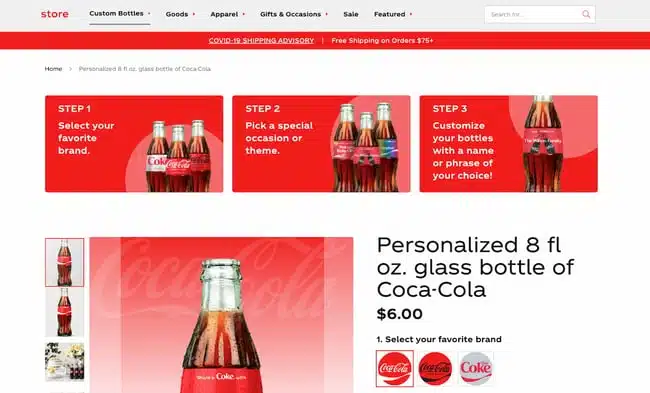
Coca-Cola doesn’t need more brand awareness, and that’s because it has built its brand so effectively over time that it has reached iconic status. One example is its “Share a Coke” campaign, where you can find a Coke bottle with your name in-store or personalize one with a phrase.
This is a brilliant brand awareness move that capitalizes on customers’ love of personalization, and with it, Coca-Cola ensures it remains an unshakable American classic. This example shows how far personalization will get you in your brand awareness campaign, so try to personalize whenever possible. Consider allowing customers to add their names if your product isn’t disposable.
#3. Beauty Bakerie Matte Lip Whip

If your product does something incredible — such as staying put even under a stream of water — consider filming one or more videos about it. That’s what Beauty Bakerie did with its now-famous Matte Lip Whip products.
I remember when my Instagram feed was filled with videos of people putting Matte Lip Whip swatches under water and washing them with soap. It was so incredible that I couldn’t help but look at the brand. Behold, I was now aware of Beauty Bakerie and have been following them ever since.
Show off something about your product that might shock your audience to learn more about you. It’s guaranteed to work like it did for Beauty Bakerie.
#4. Naked Juice
Naked Juice used Facebook and Instagram video and photo collection format ads with the reach objective for its brand awareness campaign. Both feed and Story ads used strong imagery and large text overlay to raise brand awareness with or without sound.
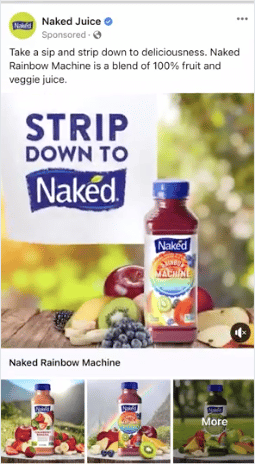
The campaign saw a 3.7-point lift in brand awareness.
Brand Awareness Idea Checklist
Lamphills Brand Awareness Idea Checklist
What Are the Ways to Raise Brand Awareness?: Effective Brand Awareness Ideas
There are some first steps to any marketing strategy and any concept, and brand awareness is one of them. Have you built buzz around your name? Are you looking to rebrand your product, or do you need to start from scratch?
First, take a good look at your metrics. See the type of engagement you have on social media, the traffic you have on your website, and the rate at which your email list grows, and make sure to make educated guesses.
Once you begin to work on your strategy, ensure your visual branding is built around the message you are trying to convey. This goes for logo colours, shapes, and the overall feel of your website and social pages.
But let’s be more specific.
#1. Build a Unique Brand
Brand building is an essential first step for brand awareness. That means you need to understand your brand and what it represents clearly. What does your brand look like? Sound like? Stand for?
Some critical components of a unique brand include:
Brand Voice
What kind of tone do you use? Are you formal or casual? Cheeky or serious? Playful or business?
You don’t need to use the same tone in every format. For example, your brand voice on social media might be more light-hearted and fun than the voice you use in print ads. Your voice might even shift a little from Facebook to TikTok.
However, how you speak to customers about your product should ultimately be recognizable across channels. Choose some consistent keywords and phrases and follow your style guide.
Brand Aesthetic
Consistency is crucial to brand building and awareness. This is true for your look and words.
What are your brand colours? Fonts? What is your overall look on visual platforms like Instagram and TikTok?
For example, look at these Instagram posts from Old Navy, Banana Republic, and The Gap. The same company owns all three brands, but each targets a different demographic and has a social aesthetic to match.
Brand Values
We’ve talked about defining what you look and sound like, but brand values define who you are as a brand. Clear brand values are the most crucial component of building a recognizable brand.
Don’t get hung up on your ideas of what values you have to have. This isn’t all about doing charity work or making corporate donations (although those can certainly be aspects of how you live your brand values). It’s more about defining what you stand for as a brand and embodying that in your interactions with everyone from customers to employees.
Make sure your brand values align with those of your target audience. According to the Edelman Trust Barometer, 58% of consumers buy or advocate for brands based on their beliefs and values, while 60% of employees use beliefs and values to choose their employer.
This is not about lip service. What you do is at least as important as what you say.
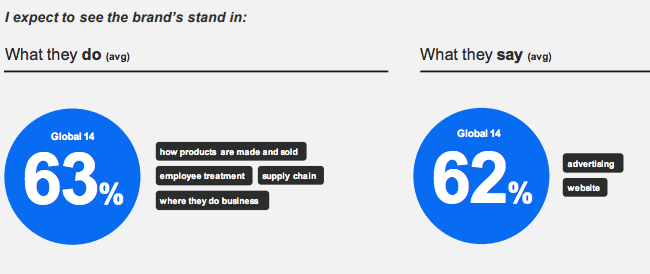
Logo and Tagline
You could argue that these are part of your brand voice and aesthetic, but they’re important enough to deserve to be called out on their own. These are the instantly recognizable representations of your brand.
If you read “Just Do It” or see the iconic swoosh, you don’t need anyone to tell you you’re looking at a Nike product or ad. Red Bull gives you what? (Say it with me now: Wings.) Put some thought into these aspects of your brand, as they’ll become the currency of your brand.
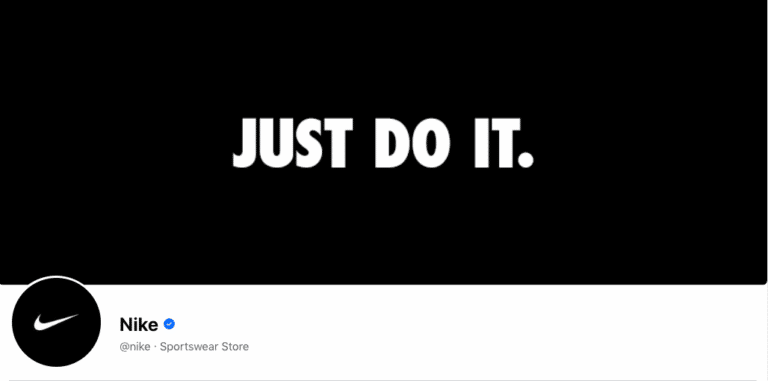
Read also: Branding Beyond Logos: Unveiling the Power of Holistic Strategies
#2. Create Stellar Content
A brand that connects with its audience can, at worst, remain at the top of the mind. Of course, you should be mindful of your content marketing strategies and the personality you show to the world.
A brand that contacts its customers when there’s a sale or when it’s desperately trying to generate more leads and reach its sales KPIs but wouldn’t know how to approach them outside of these circumstances is not a brand that customers will remember down the line.
So, craft your narrative and weave it throughout your efforts. Tell your brand’s story and ensure it’s all over your social media accounts, blog, and marketing materials, including your email marketing strategy. Additionally, you will need to have good writing skills to do this. Do it yourself, hire someone professional, or get help from writing tools.
Creating content with a story to tell will elicit an emotional response. For example, Starbucks’ calming setting, easy omnichannel setup, and friendly tone made it the perfect place for people to grab their laptops and get to work. People love a narrative with which they can connect.
#3. Create Value Beyond Your Product
A fundamental way to build long-term brand awareness is to create value beyond your product. Think about ways you can inform, educate, or entertain.
Do you or your team have specialized expertise? Don’t keep it to yourselves! Share your knowledge through a blog, podcast, YouTube channel, or newsletter.
This shouldn’t be about making sales directly. Instead, this relationship-building and brand-awareness practice creates more opportunities for audiences to get to know your brand.
For example, Patagonia creates films that align with its brand values and story. Their products appear in the movie, but there is no hard sell. The value is in the films themselves. The webpage where the films live says, “We are a collective of storytellers who make films on behalf of our home planet.”
#4. Social Media Marketing
With the number of social networks constantly increasing, trying to do active social media marketing on all of them is a fool’s errand. If your business is best suited to a particular network, don’t be afraid to put most of your energy into a few sites.
For example, photo-heavy sites might focus on Instagram and Pinterest. B2B companies often do best on Twitter, whereas small businesses in creative industries (like craft marketing) can do well on Instagram. Know where your audiences hang and focus on those networks. You won’t want to abandon the other social sites, but save your most extensive efforts for what you know works. Not sure about your core network? Start digging into analytics to see where your referral traffic is coming from.
Read also: 6 Social Media Marketing Tips To Establish Brand Authority
#5. Offer a Freebie
Everyone loves a freebie. Offering something for free is a good way to convince skeptical potential customers to try your product and create buzz about your brand online.
Whether a free sample, a free trial, or a “freemium” business model, a free taste of what you offer helps get people in the door and spreads awareness of your brand.
What’s the difference between a free trial and a freemium?
In a free trial, you offer all or a version of your regular product or service for free for a limited time – usually 7, 14, or 30 days.
With a freemium business model, you offer a basic version of your product for free indefinitely with the option to upgrade to a paid plan for more advanced features. For example, Hootsuite offers a limited free plan and a 30-day free trial on the professional plan.
#6. Referral Programs
More than 49% of U.S. consumers say friends and family are their top sources of brand awareness. The effectiveness of referral programs has been proven time and time again.
PayPal and Dropbox didn’t become industry giants by accident: they knew that the secret to building more brand awareness was hiding in their existing customer base all along.
Take Dropbox, which introduced a refer-a-friend feature in 2008. They grew their customer base by 3,900%—not a typo! This immense growth didn’t just come from the referral program—they improved their product and delivered outstanding customer service in the meantime—but it certainly did help.

PayPal did the same thing (back in the day, so hold your horses!), except they gave their users actual money instead of storing space in the cloud.
But referral programs to boost brand awareness aren’t just for the big boys. The same technique can be used to promote many products and services, and it’s a great way to raise brand awareness relatively cheaply.
#7. Try Influencer Marketing
Influencer marketing is among the best marketing strategies and ideas today to increase brand awareness. Not just that. Collaborating with influencers in your niche who have truly engaged followers exposes your brand to relevant audiences – people who are likely to buy from you. This access to an audience gives you better-quality leads, which can result in more conversions.
Studies have shown that recommendations from influencers can increase purchase intent by 5.2X when combined with brand tweets. Influencer marketing is an amazing way to give your campaign a personal touch and speak directly to your target audiences. When influencers recommend your products, you are seen by newer audiences, and they start trusting you, too.
#8. Sponsor Events
How many festivals, concerts, fairs, and exhibitions have you attended? These events are typically not possible without brand sponsorships. (Look at a t-shirt, koozie, or string backpack you likely grabbed from the event. See any brand names?)
Sponsoring events is a surefire way to get your brand in front of hundreds, thousands, or millions of people who likely fall into your target audience. Your brand name will be everywhere if you sponsor an event, from banners to flyers to water bottles.
Sponsoring an event also allows you to pin your brand name on an event that matches your personality, interests, and passions. This means consumers will associate your brand with that event and its aesthetic and character. Sponsoring an event can also help your company build brand awareness among highly specialized and qualified audiences. Professionals don’t attend events just for fun. They attend to learn the latest developments in the industry.
It’s more than just being a booth in a sea of booths. By being a consistent event sponsor, you’ll cement yourself in attendees’ minds as a leader in the field. The key is to be consistent in your sponsorship.
Consider Red Bull. Red Bull is an energy drink; without any brand awareness efforts, we’d simply consider it an energy drink. Thankfully, Red Bull took its marketing to the extreme by consistently sponsoring extreme sporting events like cliff diving and motocross. They also sponsor athletes. Now, we inherently associate Red Bull with daring and adventurous … and believe that, if we drink it, we can be the same.

How to Measure the Success of Your Brand Awareness Campaign
The ideas and tactics I’m about to show you range from monitoring certain website traffic to conducting regular brand tracking studies throughout the year. Ideally, you should combine these ideas and tactics to get an accurate view of your brand awareness. Ultimately, all the data you need is already in your organization; you just need to know where to look.
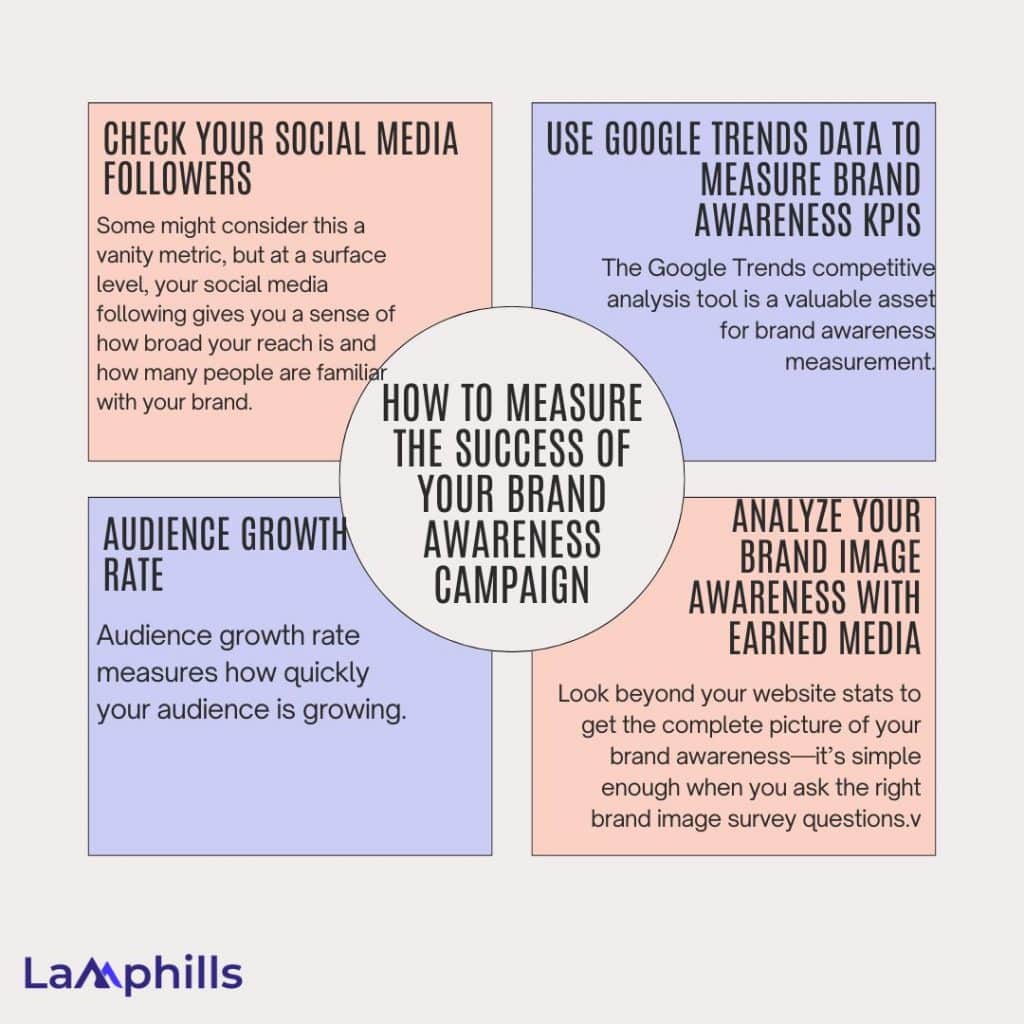
Here are tried and tested ways that help you measure brand awareness based on the most important brand awareness metrics. Please note that there’s no one-size-fits-all approach to brand awareness analysis, and you’ll have to combine them to give more context to the data:
#1. Check Your Social Media Followers
Some might consider this a vanity metric, but at a surface level, your social media following gives you a sense of how broad your reach is and how many people are familiar with your brand.
Assuming most people will follow you because they’re interested in and like you, it gives you a pretty good picture of your brand awareness.
This also means these people are more likely to see your content more frequently, which means they’re less likely to forget who you are and what you’re up to. Staying front of mind in a market full of established and emerging brands is key to maintaining familiarity.
Keep an eye on your posts’ reach—aka the number of eyeballs your content gets in front of—and use this metric to plan your posts for optimum brand awareness. Suppose posting at a particular time of day results in better reach; factor that in for future posting. Get granular with it!
#2. Use Google Trends Data to Measure Brand Awareness KPIs
The Google Trends competitive analysis tool is a valuable asset for brand awareness measurement. It roams the internet looking for mentions of your brand, so you can examine whether those mentions are increasing or decreasing over time. You can also benchmark this data against your competitors.
Again, context is important here; it’s crucial to consider your brand and marketing activities when drawing insight from Google Trends data. It’s also important to note that using Google Trends data is harder for those with more generic brand names or names that are already associated with something else.
#3. Audience Growth Rate
Audience growth rate measures how quickly your audience is growing. This provides great signals of brand awareness, as followers are more likely to know about and recognize your brand than people who don’t yet follow you.
To calculate audience growth rate, divide your number of new followers over a certain period by your total existing followers. Then, multiply by 100 to get your audience growth rate as a percentage.
#4. Analyze Your Brand Image Awareness With Earned Media
Look beyond your website stats to get the complete picture of your brand awareness—it’s simple enough when you ask the right brand image survey questions.
Alternately, if you’re mentioned on third-party websites, you’ll generate extra publicity and, therefore, awareness. While it does not directly measure brand awareness, combining this tactic with the one mentioned above will show you how third-party publicity contributes to your brand awareness over time. This will help you make sense of the effectiveness of your brand awareness campaigns.
If you’re unsure how to start tracking your brand awareness, you may want to work alongside a brand-tracking company that can help you understand the more complicated side of brand analytics. They can also help you understand how to target customers view your brand. Get a head start with these brand identity examples.
Which Is the Highest Form of Awareness for a Brand?
Top-of-mind awareness (TOMA) is the highest form of brand awareness, and it occurs when a brand is the first thing that comes to mind when a consumer thinks of a product or industry. TOMA is a key concept in market research and is considered the ultimate goal of brand building. It’s important because it can lead to customers instinctively seeking out a brand’s products and more effective marketing.
Bottom Line
It may seem like an uphill battle, but building brand awareness is not hard if you know what to do and the order in which every brand must perform the above steps.
Brand awareness will show your audience how valuable you are. But never forget that creating brand awareness is an ongoing effort that requires testing and implementing new ideas to reach even bigger audiences.
Similar Article
- BRAND RESONANCE: Elevating Brand Resonance Through Experiential Engagement
- The Top 2024 Brand Mention Tools (All You Need)
- BRAND ASSETS: 13 Examples That Will Strengthen Your Band
- 9 Personal Branding Hacks for Insane Growth in 2024






